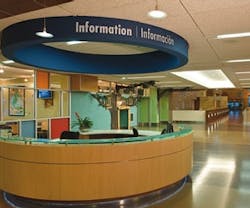Dell Children’s Medical Center
Visiting a hospital isn’t usually a walk in the park, but it could practically be mistaken for one at Dell Children’s Medical Center of Central Texas, in Austin. The 473,000-square-foot facility is constructed around six courtyards and a healing garden. Huge windows look out on the open spaces and flood the interiors with natural light.
As charming as these courtyards may be, the space is actually greener on the other side of the glass. The 169-bed Dell Center became the first hospital ever to earn a LEED Platinum-level certification, the highest designation granted by the USGBC. The criteria for high-level LEED certifications are based on office buildings that typically aren’t occupied around the clock and don’t share many of the same needs as a health care setting; so it’s challenging for medical facilities to meet the requirements.
“There are things you can do in an office building at 3 a.m. when there’s no one around that can’t be done in a hospital,” points out Joseph Kuspan, the lead architectural designer on the Dell project, and a senior vice president and director of design with Karlsberger, of Columbus, Ohio. “In office buildings you can recirculate air and not worry about spreading infections. With sick people, children, immunocompromised people—or in the case of an adult hospital, the elderly population—you’re always very challenged there. Also, in a hospital it’s 24/7 occupancy; you can’t flush the building out at 4 a.m. with nighttime air.”
Local and regional materials are incorporated into the Dell Center, and their distinctive appearance makes them natural wayfinders for navigating the building. Instead of following the yellow brick road, a patient might be guided to his or her destination by an almost 900-foot-long wall constructed of red stone. The stone was a traditional material for construction of civic buildings in the Texas Hill Country: San Antonio’s City Hall is a prime example. The architects had an old quarry reopened to provide the stone.
In many cases throughout the hospital, “It’s not just the product itself that’s sustainable, but the products you use to clean it—you’re not using harmful chemicals to maintain the product,” says Kuspan. Spills can be wiped off solid surface countertops and high-performance fabrics. The linoleum floors don’t require an endless cycle of waxing, stripping and rewaxing.
The design team decided to minimize the use of PVC wall fabrics, corner guards, and the like in the Dell Center. Other choices included the linoleum floors, low-VOC finishes, carpets fabricated entirely from recycled materials, and even attaching signage with mechanical fasteners instead of adhesive. “It was utterly amazing to walk in the building before it was occupied, and not to smell anything. I’ve never been in a new building that didn’t have that new building aroma,” affirms Kuspan.
| Back to list | Back to previous article << | >> On to next article |
